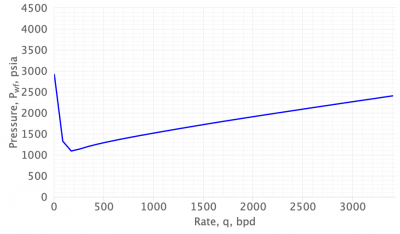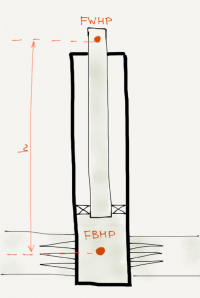VLP
Contents
Vertical Lift Performance
Vertical Lift Performance curve is a relationship between the flow rate and the pressure.
VLP curve shows how much pressure required to lift a certain amount of fluid to the surface at the given well head pressure.
VLP curve is used in Nodal Analysis PQplot software for production systems design, analysis and optimization.
Math and Physics
This is a wellbore schematic. We have the reservoir, perforations, bottomhole, completion string and the wellhead.
The depth of the well is h. The two pressure points of importance are flowing bottom hole pressure FBHP and flowing well head pressure FWHP.
To build the VLP curve we need to calculate the bottom hole pressure given the well head pressure for the different well rates in a range form 0 to AOF.
To do it we need to solve the Energy balance equation.
This equation relates the pressure to the distance for the given mass.
It has 3 terms: Gravity, Friction and Kinetic.
To find the required lift pressure we need to integrate this equation over the fluid’s travel distance.
All available VLP correlations are solving the same equation.
The differences are usually in the way how the friction term is calculated.
Oil well VLP correlation
Hagedorn and Brown is the default VLP correlation for the oil wells in the PQplot.
Gas well VLP correlation
Fanning correlation is the default VLP correlation for the dry gas wells in the PQplot. Gray is the default VLP correlation for the gas wells in the PQplot.
VLP calculator software
- PQplot nodal analysis software is used to calculate the VLP curves. PQplot is available online at www.pengtools.com.
- Excel
- other



